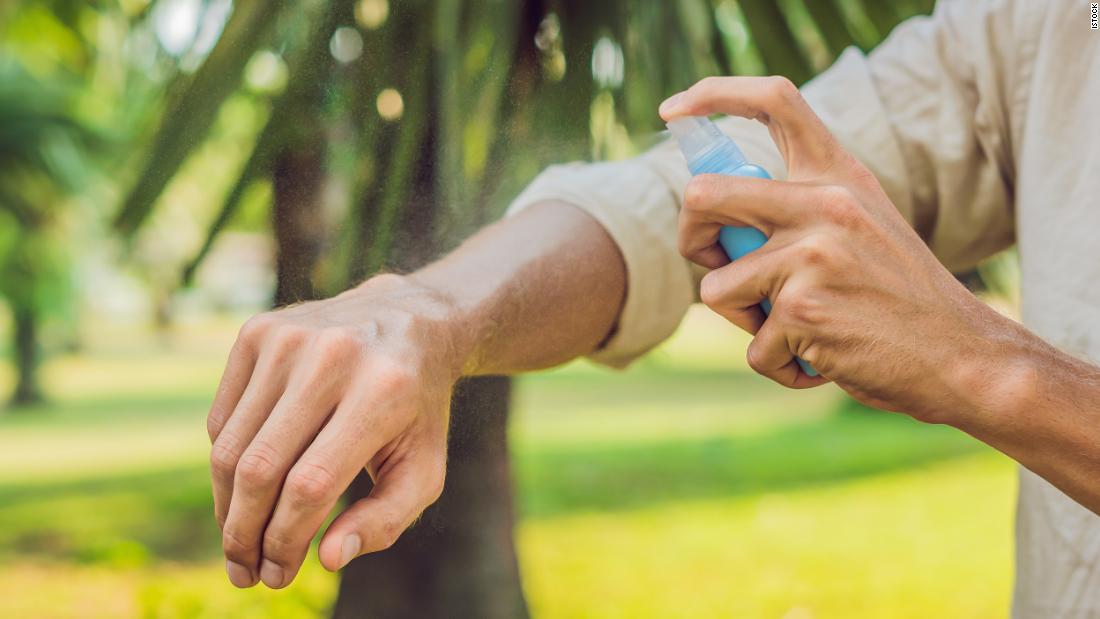CNN
—
Nothing ruins a sojourn outdoors quite like an entourage of pesky mosquitoes chowing down on your arms and legs. Sure, bug spray is great and all. But between the various active ingredients and concentrations, it’s hard to know what actually works, let alone find a spray that doesn’t smell like a chemistry class or make you feel like you took a dip in a vat of oil.
That’s why we went hands-on with bug repellents to test how they feel, how they smell and everything else you’d want to know about a bug spray before you use one. All this after consulting with multiple experts to ensure we included repellents that are actually effective at, well, repelling bugs. We tested only bug sprays that have an active ingredient approved by both the Centers for Disease Control and Prevention (CDC) and Environmental Protection Agency (EPA): DEET, picaridin, oil of lemon eucalyptus, p-Menthane-3,8-diol (which is in oil of lemon eucalyptus), IR3535 and 2-Undecanone. DEET was the resounding favorite among the experts we interviewed, but they all praised the effectiveness of the other ingredients as well, especially picaridin and oil of lemon eucalyptus.
To be clear, we didn’t test each spray for its efficacy at repelling bugs, since there are so many external variables that go into that. Instead, we used our extensive research and the opinions of experts to choose a pool of sprays that science has proven to be effective.
After multiple weeks of testing, we found three bug sprays that stood above the rest:
The Proven Insect Repellent Spray proved to be a winner during our user testing. The bottle boasts a quick and easy spray (it’s also one of the most portable bottles), and users noted its near complete lack of scent. Even with its wide coverage, Proven was nice and light to the point we barely felt it on our skin. While you might forget you’re wearing it, though, bugs won’t. We found in our research (and the experts agreed) that the active ingredient picaridin — Proven’s active ingredient comprising 20% of its formula — is one of the best at repelling bugs.
Coming just shy of first place was the Coleman SkinSmart DEET-Free Insect Repellent Spray, a 30% IR3535 aerosol bottle that shined all around. It had a consistent, wide spray, and the aerosol can made it super easy to spray ourselves quickly. It dried instantly and didn’t leave any greasy residue on our skin.
The best-scoring DEET option was the Cutter Backwoods Insect Repellent, which is a 25% DEET formulation. We didn’t love any of the DEET repellents we tested, as they often smelled bad or felt greasy on our skin. Cutter’s bug spray scored better than the other DEET picks in our pool, largely due to its relative durability and its consistent scoring in most of our tests. So if you’re looking for the science-backed, consensus best active ingredient for repelling insects, DEET is your go-to. And since Cutter wasn’t as harsh-smelling (or as greasy) as the rest we tested, we think it’s the ideal DEET choice.
Proven Insect Repellent Spray
This picaridin formula from Proven is one of the most portable options, perfect for hikers or for simply stashing in your bag so you’re always prepared. The nozzle, despite its small design, is incredibly consistent and applies evenly. It isn’t an aerosol can, but it’s equipped with a long pump, so spraying felt nice and easy, even though it gets harder when you spray it upside down (since, thanks to gravity, the straw may no longer be submerged). Despite that fact, it didn’t take us a long time to spray ourselves. With an average application time of just over 21 seconds, it was the fastest pump spray we tested.
Proven Spray’s scent is largely, well, nonexistent. Each bug spray went through two separate testers, and both testers who used Proven said they could barely smell anything. No wafting tears-inducing chemical odor. The Proven also wasn’t greasy and had a nearly perfect score for the way the spray felt on our skin. It was easy to forget that we even applied this spray — besides the fact no bug would dare touch our skin.
The Proven repellent was also remarkably portable, thanks in part to its slim bottle. It can fit in basically any bag, but it’s not so small that you’ll easily lose it. (If you do prefer a pocket-size spray, this repellent is available in a smaller, 2-ounce spritzer.) The bottle also comes with a simple cap to protect from any leaks, which held up well during some stress testing. While it doesn’t provide perfect protection because it can fall off, when one of our testers threw it in a bag and went for a bike ride it stayed completely secure.
We absolutely love the way the Proven disappears on our skin and its basically scentless formula. If you’re looking for an insect repellent that’s easy to use and easy to forget, you can’t get much better than the Proven Insect Repellent Spray.
Coleman SkinSmart DEET-Free Insect Repellent Spray
Coming in just shy of first place in our ratings is the Coleman SkinSmart DEET-Free Insect Repellent Spray. It was one of our best sprays in the performance category (which covered tests such as spray smell, feel, quality and others), falling just a little short in portability due to its slightly bulky bottle.
The IR3535 repellent had a wide, even spray that made application a breeze. And since it’s an aerosol can rather than a pump spray, we didn’t have the problem of the pump not being submerged in the spray when applying it upside down. Instead, the aerosol pushes the repellent out, which made spraying our entire bodies a super fast process. Just be careful of spraying upside down too often, because like all aerosol products, if you do it too much, the aerosol will escape. (We had this happen with a different aerosol spray when we used it upside down too many times, which resulted in repellent stuck in the can with no way to get out. Bummer.)
The feel of the Coleman SkinSmart wasn’t greasy or sticky at all. The formula uses a drying technology that makes it disappear almost instantly on your skin. The only big speed bump we ran into with this spray was its smell. It’s marketed as odorless, and while that rang true for one of our testers, another said it had a smell of chemicals that could easily make you cough when you spray it, and that the harsh scent lingered for a while.
Another highlight of the Coleman IR3535 formula is the bottle it comes in. It’s equipped with a locking switch to keep it secure. It was right in the middle in terms of size, not big and bulky but also not slim and packable like some of the other options we tested.
If you’re looking for an aerosol repellent with similar performance to our top pick, and you’re willing to give up some portability, the Coleman SkinSmart DEET-Free Insect Repellent is the pick for you.
Cutter Backwoods Insect Repellent
During our research, we found DEET to be the consensus gold standard when it comes to insect repellents (read more on how we chose our testing pool below). But despite their reputation, sprays containing DEET didn’t score as well overall in our tests as other options. If you don’t care as much about the smell and feel of the spray and want the science-backed, best-in-class ingredient for repelling bugs, DEET is the way to go.
Out of the multiple DEET-based repellents we tested, the Cutter Backwoods Insect Repellent edged out the competition. It really came down to the Cutter and the famous OFF! Deep Woods Insect & Mosquito Repellent, but the cap of the OFF! popped off during testing and was the aerosol can that left us with repellent stuck in the bottle, so we had to knock off some points.
The Cutter had a solid spray, though it came out slightly wet and cold at times. The nozzle is larger than the others we tested, resulting in a wide area of application. This, plus its ability to spray upside down, made for ultra fast application times, clocking in at under 13 seconds on average for mostly full-body coverage.
The spray wasn’t too offensive, but still a little harsh. It has that classic chemical smell you expect from bug spray. The repellent also left a light residue that took quite a while to fully dry, but it didn’t feel terribly greasy.
While this repellent didn’t perform overly exceptionally or poorly in most of our tests, its biggest downside was the bottle’s size. It’s a bulky spray, which makes it easy to handle but hard to simply throw in your bag for a day on the trails. The size does make it quite durable, though, as both testers noted its sturdy build. And after all the testing and spraying it worked good as new, in contrast to some other sprays that had caps pop off or clogged nozzles.
If you’re looking for a DEET spray, willing to sacrifice some comfort in terms of the spray’s feel and smell, and you don’t mind carrying around a larger can, Cutter Backwoods Insect Repellent should top your list.
We selected 10 bug sprays after thoroughly researching the most effective ingredients and talking to several experts to find the best of the best at repelling insects. We chose only repellents with both an active ingredient that is both CDC– and EPA-approved, which are DEET, picaridin, oil of lemon eucalyptus, p-Menthane-3,8-diol (which is a component of oil of lemon eucalyptus, but they are regulated separately), IR3535 and 2-Undecanone.
Our experts largely echoed the CDC and EPA, praising the effectiveness of all these ingredients, but heralded DEET above all else as the industry standard. “DEET is still the gold standard to many in the public health profession,” says Elmer Gray, public health extension entomologist for the University of Georgia Cooperative Extension Service. Many of his peers also agree.
“The gold standard for insect repellents is still DEET-based products sold under a whole host of brand names,” echoes Dr. Jerome Goddard, extension professor of medical entomology at Mississippi State University. “Many studies through the years have demonstrated its effectiveness against a variety of flying insects and (somewhat) against ticks.”
While some may harbor concerns over DEET’s safety and its toxicity, all the experts we talked to said those worries are largely unfounded. “The first law of toxicology is that everything is toxic,” says Dr. Jeffrey G. Scott, professor of insect toxicology at the department of entomology at Cornell University. “It’s just the dose that determines the effect.” The EPA has concluded that DEET is safe, and many of the worrying stories of people getting seizures or even dying came after ingestion or “dermal applications not consistent with label directions.”
The EPA has been testing DEET for decades and found that if used as directed, it is completely safe for everyone, even pregnant women and children over 2 months. However, repellents with the active ingredient oil of lemon eucalyptus and p-menthane-3,8-diol aren’t recommended for children under the age of 3 because the dangers of applying them to kids under that age haven’t been thoroughly explored.
The CDC recommends using products with an active ingredient concentration of more than 10% for limited protection and says that the effectiveness of DEET plateaus after 50%. The experts we talked to agree. “In general, higher concentrations of an active ingredient provide longer duration of protection, regardless of the active ingredient,” says Dr. Eva Buckner, assistant professor and state extension specialist at University of Florida’s Institute of Food and Agricultural Sciences Medical Entomology Laboratory. “However, concentrations above around 50% do not offer a marked increase in protection time. Products with less than 10% active ingredient may offer only limited protection, often from one to two hours.” Following that guidance, all the repellents we tested have between a 10% and 30% concentration of their active ingredients.
We ran each bug repellent through the same tests to measure both performance and portability. We did not test each spray’s ability to physically repel bugs, but instead relied on our extensive research and the opinions of experts we interviewed to create criteria that all the repellents we tested met. Our performance ratings, rather, were based on tests that examined the physical quality of spray, smell and feel among other things. Since many of these tests are subjective, we had two testers evaluate each repellent and took the average of both results. Here’s a full breakdown of every test we ran:
Performance
- Spray quality: We tested how wide, even and consistent the spray was by applying it multiple times on ourselves.
- Spray smell: We smelled the spray whenever we applied it and noted how strong or weak it was and if it was a pleasant or harsh smell.
- Spray feel: We noted how the spray felt on our skin whenever we applied it, and if it was greasy or sticky.
- Spray difficulty: We tested how hard it was to spray ourselves with each repellent, noting how hard it was to hold each bottle and if we could spray it upside down.
- Spray time: Each tester sprayed themselves three times with each repellent, finding the average time it took to spray themselves. We then averaged the results from both testers to come up with an average spray time.
- Spray durability: After conducting all of our other tests, we observed how the bottle held up and if the quality of the spray was affected.
Portability
- Leaks: We examined each bottle and looked for any sort of locking mechanism or cap and judged how likely it would be to leak in a bag.
- Size: We noted how large each bottle was and threw it in a bag to see if it took up a lot of space.
- Size options: We researched how many size options are available for each repellent.
We rated the performance of each repellent as we conducted all the tests mentioned above. We gave each repellent a score for each test, added those up to find a score for each category and tallied those results to find an overall rating. Here’s a full breakdown of our scoring system:
- Performance had a maximum of 75 points: spray quality (15 points), spray smell (15 points), spray feel (15 points), spray difficulty (10 points), spray time (10 points) and spray durability (10 points).
- Portability had a maximum of 25 points: leaks (15 points), size (5 points) and size options (5 points).
OFF! Deep Woods Insect & Mosquito Repellent VIII, 2-Pack ($7.97, originally $11.89; amazon.com)
Off
OFF! Deep Woods Insect & Mosquito Repellent VIII, 2-Pack
This spray was one of the leaders early on in the testing process, but it dropped in the rankings after some durability issues. The cap popped off in a bag during a day of hiking, and after some serious spraying (much of it upside down), the aerosol in the bottle ran out, resulting in a can that still has bug repellent in it with no way to get it out. If you’re careful with the slightly more delicate can and avoid spraying it upside down too much, then the OFF! Deep Woods repellent is a top-notch pick.
Ben’s 30 Insect Repellent Spray, 2-Pack ($15.98; amazon.com)
Ben’s
Ben’s 30 Insect Repellent Spray, 2-Pack
Ben’s had an incredibly strong, unpleasant and chemical smell along with a thick and wet feel that had both of our testers antsy for a shower. Its spraying mechanism mimics the distribution you’d get from an aerosol can without actually using any of the gas — however, the spray itself came out extremely dense and sticky, which outweighed any of its other benefits.
Sawyer Products 20% Picaridin Insect Repellent ($8.99; amazon.com)
Sawyer Products
Sawyer Products 20% Picaridin Insect Repellent, 2-Pack
The pump spray on the Sawyer repellent provided short little spritzes that didn’t cover much area, so we found ourselves spraying a lot to get even coverage. Its small size makes it a little difficult to hold and spray all around, but it doesn’t have a terribly strong smell. It dried quite quickly, but the pump also got clogged quite a bit during testing. The highlight was definitely the double-locking lid, which ensured a leak-free experience.
OFF! Family Care Picaridin Aerosol ($6.89; target.com)
Off
OFF! Family Care Picaridin Aerosol
This picaridin option from OFF! also impressed our testers, with a wide aerosol spray and a fast-drying feel. One tester said she didn’t smell anything when she applied it and another smelled orange peel, so even if you do smell anything, it’s not a harsh, eye-watering scent. This repellent scored highest in our performance category, but it doesn’t have a cap or lock, is a little bulky and comes in just one size, which knocked off some points. Only one point behind our runner-up, Coleman SkinSmart spray, it’s still a high-quality option.
OFF! Botanicals Mosquito and Insect Repellent IV ($4.96; amazon.com)
Off
OFF! Botanicals Mosquito and Insect Repellent IV
This repellent is made with p-menthane-3,8-diol, but its tiny size and small pump made it hard to apply. The spray itself isn’t doesn’t apply particularly evenly and sometimes just squirts a jet of spray instead of misting, but it didn’t have a scent at all, which was a huge bonus. It’s also available in one of the smallest size options, at 2 ounces, so if you want a truly tiny spray you can fit in your pocket, this one could be for you.
Repel Plant-Based Lemon Eucalyptus Insect Repellent ($4.97, originally $7; amazon.com)
Repel
Repel Plant-Based Lemon Eucalyptus Insect Repellent
The scent of this lemon eucalyptus spray was polarizing for our testers: One loved the herby tones and the other was left coughing because of its strong and pungent smell. (Even if you do enjoy the scent, we’d recommend applying it outside.) This repellent was also extremely greasy and took a while to dry. Similar to the Ben’s spray, the first thing we wanted to do after applying it was take a shower.
Coleman Naturally Based DEET-Free Lemon Eucalyptus Insect Repellent ($9.17; amazon.com)
Coleman
Coleman Naturally Based DEET-Free Lemon Eucalyptus Insect Repellent
This spray had a pleasant smell due to its oil of lemon eucalyptus base, although it was strong at times. The pump worked well, but it took too long to apply and the bottle is a bit stubborn: You can’t spray it upside down due to its pump function, and it’s easy for your finger to slip off the small nozzle. It was oilier than other options and the spray dripped around the nozzle, making it a little messy.
Read more from CNN Underscored’s hands-on testing:









